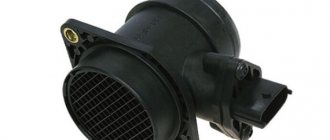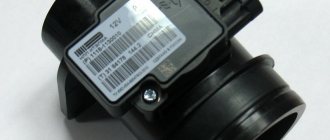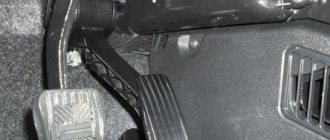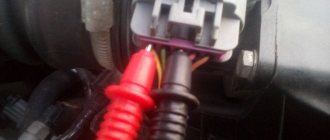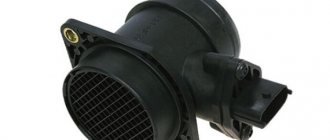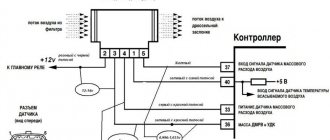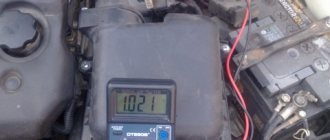Injection (injection) engines on VAZ 2107 vehicles are equipped with a time-tested mass air flow sensor from Siemens.
Of course, there is no German magic here; the sensor can fail, like any other equipment. The car will not stop, the engine will not stall, but the control electronics will switch it into emergency mode. That is, the air entering the intake manifold will not be taken into account by the main “brain”; in this case, the fuel mixture is formed according to the average principle. Gasoline consumption increases, power and torque decrease.
How to check the mass air flow sensor yourself
Symptoms of a malfunctioning mass flow sensor are as follows:
- The “check engine” warning light on the instrument panel is on;
- floating idle speed with a working idle speed controller;
- with a uniform load there is no smooth running of the car;
- starting the engine is difficult (if there are other faults, it is impossible);
- fuel consumption increased unmotivated;
- noticeable loss of power (especially noticeable under load).
The Siemens VDO mass air flow sensor installed on VAZ 2107 vehicles is highly reliable, but it may appear to be faulty due to external influences. For example, contamination, water or oil entering the measuring channel, or power failure. Therefore, checking the VAZ 2107 mass air flow sensor for the injector engine begins with inspecting the sensor. It needs to be removed.
- disconnect the negative terminal from the battery;
- release the fastening clamp and separate the intake manifold pipe from the flange of the mass air flow sensor;
- carefully disconnect the power and control connectors (the temperature of the plastic clips becomes brittle);
- unscrew the fasteners and remove the sensor from the air filter housing.
We inspect the internal cavity and sensors. Conductors and fasteners of elements should not have any visual damage, there should be no dust, moisture or oil stains on the surface.
The case should also not have damage, cracks, or through abrasions.
Important: When separating the injection mass air flow sensor from the intake manifold pipe, check the integrity of the rubber pipe. Unaccounted for air leakage bypassing the flow meter can also indicate symptoms of a sensor malfunction.
Of course, existing contaminants must be removed. The cavities of the measuring channel are purged with compressed air.
Important: Wiping with a rag or brush is not allowed; there is a risk of damaging the measuring elements.
You can use special sprays (not carb cleaner or WD-40!) to clean flow meters. After cleaning, it is necessary to eliminate the cause of the dirt. Most often, debris gets into the mass air flow sensor from an untimely replaced air filter.
Checking the electrical part with a multimeter
To find out what condition the electrical circuit of the mass air flow sensor is in, you will need to pinout the Siemens VDO contacts. First we check the block on the ECU side. We fix the negative wire of the multimeter to ground and turn on the ignition. We connect the positive wire to contact No. 5 of the block: normal supply voltage is 12 V. Similarly, we check contact No. 4; normal voltage is 5 V. If the values are different, check the ECU or the wiring harness from the mass air flow sensor to the engine control unit.
Important: The reason for the loss of supply voltage may be simple corrosion of the contacts; the operating conditions of the sensor are far from ideal.
How to check the sensor for the correct output signal? Using a diagnostic scanner (ideal) or the same multimeter. The output contact readings show not only the serviceability of the mass air flow sensor, but also the remaining resource.
It is necessary to connect the positive wire to the signal contact of the connector (on the VAZ 2107 this is green No. 3), and the negative wire to ground. The multimeter is set to a measurement range of up to 2 V, the error is up to hundredths of a voltmeter.
After turning on the ignition, the device should display a value of about 1 volt.
- readings from 0.9 V to 1.02 V – the DMF works perfectly;
- from 1.03 V to 1.05 V – service life is coming to an end;
- more than 1.05 V, or absent altogether - the sensor must be replaced.
Note: Repairing the mass air flow sensor is not practical due to the low cost of the device itself and the complexity of the design.
In the design of sevens with injection-type engines, a mass air flow sensor is installed. The abbreviation stands for mass air flow sensor, which has a direct impact on the quality of engine operation. If the mass air flow sensor on a VAZ 2107 begins to malfunction, the engine will still work, but it is not recommended to operate it for such a long time. If this element breaks down, it should be replaced immediately.
TEST SEQUENCE
HINT: Use a handheld diagnostic tool to read the fixed parameters. These parameters reflect the state of the engine at the time the malfunction was detected. When troubleshooting, fixed parameters allow you to determine whether the car was moving at the time of the malfunction or not, whether the engine was warmed up, what the air-fuel mixture was (lean or rich), etc.
| 1.TAKE HAND-HELD TEST READINGS (MASS AIRFLOW) |
Connect the handheld diagnostic tool to the DLC3.
Start the engine and turn on the handheld scan tool.
Select the following menu items: Powertrain / Engine and ECT / Data List / MAF.
Read the values displayed on the scan tool.
Result:
| Air mass flow (g/s) | Next step |
| 0,0 | A |
| Not less than 271.0 | B |
| Between 1.0 and 270.0 (*1) | C |
*1: The value should change when the throttle valve is opened or closed while the engine is running.
| B |
Go to step 6 C
CHECK FOR INTERMITTENT PROBLEMS
| A |
| 2.CHECK MASS AIRFLOW SENSOR (SUPPLY VOLTAGE) |
Disconnect the mass air flow (MAF) sensor connector B1.
Turn on the ignition (IG).
Measure the voltage between the harness-side connector pin and ground.
Rated voltage:
| Contacts for connecting a diagnostic tool | Specified conditions |
| +B (B1-3) - mass | 9-14 V |
Reconnect the mass air flow sensor connector.
| NG |
Go to step 5
| OK |
| 3.CHECK MASS AIRFLOW SENSOR (VG TERMINAL VOLTAGE) |
Check the output voltage.
Disconnect connector B1 of the MAF sensor.
Apply battery voltage to terminals +B and E2G.
Connect the scan tool positive (+) probe to terminal VG and the scan tool negative (-) probe to terminal E2G.
Rated voltage:
| Contacts for connecting a diagnostic tool | Specified conditions |
| VG (5) - E2G (4) | 0.2-4.9 V |
Reconnect the mass air flow sensor connector.
| NG |
REPLACE MASS AIRFLOW SENSOR
| OK |
| 4.CHECK HARNESS AND CONNECTOR (MASS AIRFLOW SENSOR - ECM) |
Disconnect connector B1 of the MAF sensor.
Disconnect ECM connector B32.
Nominal resistance (check for open):
| Contacts for connecting a diagnostic tool | Specified conditions |
| VG (B1-5) - VG (B32-118) | Less than 1 ohm |
| E2G (B1-4) - E2G (B32-116) |
Nominal resistance (check for short circuit):
| Contacts for connecting a diagnostic tool | Specified conditions |
| VG (B1-5) or VG (B32-118) – weight | 10 kOhm or more |
Reconnect the mass air flow sensor connector.
Connect the ECM connector.
| NG |
REPAIR OR REPLACE HARNESS OR CONNECTOR
| OK |
| REPLACE ECM |
| 5.CHECK HARNESS AND CONNECTOR (MASS AIRFLOW SENSOR - INTEGRATED RELAY) |
Disconnect connector B1 of the MAF sensor.
Remove the integrated relay from the No. 1 relay block in the engine compartment.
Nominal resistance (check for open):
| Contacts for connecting a diagnostic tool | Specified conditions |
| +B (B1-3) - 1A-4 | Less than 1 ohm |
Nominal resistance (check for short circuit):
| Contacts for connecting a diagnostic tool | Specified conditions |
| +B (B1-3) or 1A-4 - mass | 10 kOhm or more |
Reconnect the mass air flow sensor connector.
Reinstall the integrated relay.
| NG |
REPAIR OR REPLACE HARNESS OR CONNECTOR
| OK |
| CHECK ECM POWER CIRCUIT |
| 6.CHECK HARNESS AND CONNECTOR (SENSOR GROUND) |
Disconnect connector B1 of the MAF sensor.
Nominal resistance:
| Contacts for connecting a diagnostic tool | Specified conditions |
| E2G (B1-4) - mass | Less than 1 ohm |
Reconnect the mass air flow sensor connector.
| OK |
REPLACE MASS AIRFLOW SENSOR
| NG |
| 7.CHECK HARNESS AND CONNECTOR (MASS AIRFLOW SENSOR - ECM) |
Disconnect connector B1 of the MAF sensor.
Disconnect ECM connector B32.
Nominal resistance (check for open):
| Contacts for connecting a diagnostic tool | Specified conditions |
| VG (B1-5) - VG (B32-118) | Less than 1 ohm |
| E2G (B1-4) - E2G (B32-116) |
Nominal resistance (check for short circuit):
| Contacts for connecting a diagnostic tool | Specified conditions |
| VG (B1-5) or VG (B32-118) – weight | 10 kOhm or more |
Reconnect the mass air flow sensor connector.
Mass air flow sensor on VAZ 2107
The injection engine is controlled by electronics that receive information from various sensors, adjusting the supply of the fuel-air mixture and ignition. The mass air flow sensor shows the volume of air supplied to the combustion chamber. Against the background of data received by the ECU, the dosage of gasoline is calculated, forming the optimal amount of the fuel-air mixture.
DMRV VAZ 2107 injector is located between the throttle valve and the air filter element (it is mounted in the pipe). The device in question is based on two electrical conductive threads. The principle of operation is based on temperature fluctuations of the first and second threads. To do this, one thread is located directly so that it is blown by the air sucked into the system, and the second is hidden from the influence of the air flow on it.
When air enters the system, the first thread cools, and at the same time the current resistance in the circuit decreases. The more air enters, the stronger the cooling process. The second thread is the control thread, and its resistance does not change. The difference in resistance between the first and second threads is recorded by the ECU, on the basis of which a decision is made on the need to enrich or lean the fuel mixture. If it breaks, the engine will continue to operate, but only in a mode in which the fuel mixture will be mixed in the wrong proportions.
Symptoms of malfunction
The malfunction of this sensor on the VAZ 2107 is indicated by the inclusion of the Check Engine control indicator. However, the absence of an indication does not always indicate the serviceability of the part in question. This is due to the fact that the part very rarely fails completely. Often its malfunction is manifested through incorrect readings. With such readings, the ECU receives a signal from the device, and accordingly makes an appropriate decision on the need to enrich or lean the mixture.
If there is a suspicion that the device in question is malfunctioning, then you need to pay attention to the following symptoms:
- An increase in fuel consumption is detected.
- The idle speed increases, and unstable engine operation is observed at idle.
- The car becomes less pliable by reducing power and dynamics.
- Problems with starting the engine when hot.
The MAF sensor is one of the most expensive spare parts, and if it breaks, it needs to be replaced. It cannot be repaired, but before replacing it, you need to make sure that the sensor is really faulty. If you suspect a device malfunction, you should first check the integrity of the air duct. After all, often the cause of DMRV errors is the intake of air from outside, bypassing the sensor.
Sensor failure may be minor when the surface of the platinum filament becomes dirty. In this case, it can be cleaned. First, let's figure out how to check the device for serviceability.
Checking the mass flow sensor with your own hands
The serviceability of the device in question can be determined with high accuracy only in a car service center that has specialized equipment. However, not every car service center has a special stand, and even if it does, it’s not good to go for diagnostics every time with the above-mentioned symptoms in order to find out the cause. Instructions on how to check the sensor at home include the following steps:
On a VAZ 2107 injector, it is recommended to install a Siemens-branded air flow sensor made in Germany. MAF pinout for Siemens:
- +12V.
- +5V from the ECU.
- Signal.
- DTV.
- Weight.
Removal and installation of the seven mass air flow sensor
If the part in question is faulty, it should be replaced. Replacing the air flow sensor on a VAZ 2107 is carried out according to the following instructions:
- The clamp that secures the air duct is loosened.
- After this, you need to remove the air duct pipe and unscrew the bolts securing the sensor to the filter.
- Disconnect the power supply from the device and remove the element from the car.
- A new sensor is installed, and finally it remains to tighten the clamp securing the air exhaust hose.
When the old mass air flow sensor is dismantled, you can clean it. Before cleaning the sensor, it must be disassembled. Platinum thread is cleaned with alcohol. The block connector must also be inspected for oxidation. Fixing a breakdown of the mass air flow sensor on the seven can be resolved quickly if it is clearly established that the cause is a faulty sensor.
The VAZ 2107 has been produced for a very long time and during this time has remained virtually unchanged, with the exception of the engine. Initially, the seventh Lada model rolled off the assembly line with an engine with carburetor fuel injection, but time passed and AvtoVAZ needed to modify the car and adjust it to EURO standards. Therefore, the carburetor engine was replaced by an injector.
As you know, injection engines have a large number of different sensors that are involved in the operation of the internal combustion engine. Failure of at least one of the sensors can lead to a malfunction of the engine and a change in its characteristics.
In this article we will talk about the mass air flow sensor on the VAZ 2107, namely its purpose, signs of malfunction, design, cost, methods of self-checking and replacement.
Replacing the air flow sensor
After confirmation of a malfunction in the operation of the sensor, it must be replaced. Considering the fact that this element cannot be repaired, the procedure for removing it is greatly simplified. Naturally, you need to turn off the engine; this is a common safety measure for performing work. The next step is to turn off the power supply. After loosening the clamp located on the filter outlet, you can remove this element.
The sensor is secured with two 10mm bolts. Armed with the appropriate wrench, you can remove them without any problems. The element is completely ready for extraction. There is no need to rush to install a new mass air flow sensor. First of all, you should carefully check the condition of the O-ring, as well as its tightness. If it is even slightly deformed, unpurified air may leak in, which will significantly accelerate the failure of a completely new device for determining air flow.
If everything is normal, you can proceed with installation. The procedure is very simple; you need to repeat the entire removal process in reverse order. Now you can perform the check, turn on the ignition and test the engine with a new, working sensor.
DMRV VAZ 2107
This sensor is installed on the VAZ 2107 by the German company Siemens. This brand is well known in the market and makes fairly high-quality parts, so the mass air flow sensor of this company works for a very long time and reliably.
The sensor is installed on the air filter housing and an inlet corrugation is attached to it, through which air passes and enters the engine.
Replacement
It is not difficult to replace the mass air flow sensor with your own hands, even if you do not have any special skills in car repair. Having checked the condition of the device and determined that cleaning will not help, all that remains is to replace it.
- Place the car on a level surface, lift the hood and remove the negative terminal from the battery.
- Disconnect the sensor connector. We have already talked about its location, so there will be no problems with the search.
- Using a screwdriver, remove the clamping bolt of the clamp that secures the corrugation to the mass air flow sensor.
- The corrugation is removed.
- Using a 10mm wrench, unscrew the two bolts that hold the sensor to the air filter housing.
- After removing the failed oxygen sensor, install a new regulator in its place.
- Screw back a couple of bolts, secure the corrugation and secure it with a clamp.
- Reconnect the connector and return the negative terminal to the battery.
If everything is done correctly and the breakdown is correctly identified, then the engine will return to its previous performance and the error signal on the dashboard will disappear.
Replacing the device
To finally check the result of the repair, go out onto the road, do a test drive and be sure to try to press the gas pedal sharply. If the dynamics and power become the same as before the problems arose, you did everything correctly, and it was the mass air flow sensor that was the culprit of the malfunction.
Purpose and design
The purpose of the mass air flow sensor is to count the air that enters the engine to mix with fuel to form the fuel mixture. In order for fuel and air to be mixed in the required proportions, it is necessary to determine how much air enters the engine at a certain point in time - this is the main task of the mass air flow sensor.
Structurally, the sensor has a cylindrical shape inside, which contains a special sensitive element, which determines the volume of air passed through the sensor. On top of the mass air flow sensor there is a connector to which the power and control circuit is connected; this circuit is connected to the electronic engine control unit.
Sensor design
The device comes in two types: film or thread (wire). If we talk about fundamental differences, then in the first type of sensor the role of the sensitive element is played by a film with a resistor made of platinum fixed on it. In the second case, a wire made of the same metal works. It is clear that purchasing a new mass air flow sensor is not cheap.
The contamination of the device is related to the condition of the air filter. If it does not meet the standard, then particles of dust and dirt begin to settle on the elements of the mass air flow sensor. As a result, the device stops functioning: measuring the mass of air supplied inside the power unit.
Symptoms of a problem
Signs of a malfunction of the mass air flow sensor may be similar to the breakdown of other sensors; computer diagnostics using ADC channels will help to more correctly identify a faulty mass air flow sensor.
Signs of a faulty mass air flow sensor:
- Increased fuel consumption;
- Unstable operation of the internal combustion engine in all modes;
- Difficulty starting the engine;
- Loss of power and dynamics;
If your car has such breakdowns, then most likely you need to check the mass air flow sensor.
What are the signs of a malfunction of the mass air flow sensor on the Priora and the corresponding error codes
The main problem with mass air flow sensors on Priora and other cars is contamination of the sensitive element. The more contaminants on the surface, the higher the level of error, which leads to incorrect readings received by the ECU. If the controller receives incorrect readings, then based on them the air-fuel mixture and advance angle are adjusted. Signs of a malfunction of the mass air flow sensor on a Priora are the following:
- Reduced power and vehicle dynamics.
If, when you press the accelerator pedal sharply, a deteriorated response is detected, then you need to check the mass air flow sensor. - Fuel consumption increases
. Moreover, its value can increase to 12-13 liters per 100 km. - It is difficult to start the engine or the engine may not start at all due to the spark plugs being flooded with fuel.
- Increasing or floating idle speed.
However, such signs can only indirectly indicate that the mass air flow sensor has failed. The corresponding error codes on the on-board computer of the Lada Priora will also help you verify that it is faulty:
- P0102 - a low signal level is received from the mass air flow sensor;
- P0103 - a high signal level is received from the mass air flow sensor;
- P0110 - malfunction of the air flow sensor circuit;
- P0112 - low signal level from DTVV (intake manifold air temperature sensor);
- P0113 - high level of DTVV signal.
The display of the last three errors indicates a malfunction of the thermistor, which is responsible for measuring the intake air temperature. If corresponding errors or the above-described symptoms are detected, it is necessary to resort to checking the condition of the mass air flow sensor on the Priora.
Checking the mass air flow sensor
Checking the air flow sensor can be divided into 4 stages: shutdown, using a multimeter, visual and computer.
Disconnection test
This test is the simplest and most accessible, but does not provide 100% information about the performance of the sensor.
So, to check you need to disconnect the connector from the sensor and start the car. Then you need to drive the car and evaluate its dynamic performance. If the car begins to accelerate better and operate more stably, then it is most likely that the mass air flow sensor is still faulty.
Checking with a multimeter
This test is more complex, but every owner of a VAZ 2107 can do it. To carry out diagnostics using this method, you must have a regular household multimeter that is capable of measuring DC voltage.
- We set the multimeter switch to measure DC voltage.
- We connect one multimeter probe to ground, and the second to the terminal on the mass flow sensor connector numbered “5” (the wire block is numbered). The voltage between these two points when the ignition is on should be 12V.
- Next, we move the probe to pin “4”; the voltage at this pin should be 5V.
If the readings differ, the sensor is faulty or the battery is discharged.
Visual inspection
The condition of the sensor can be assessed visually after its dismantling. When the sensor is removed, it is necessary to evaluate its internal parts, they should be intact without traces of dirt, dust and oil. In some cases, simply cleaning the sensitive element helps bring the sensor back to life.
Testing with the device
This check can be carried out using a special diagnostic tool via ADC channels. This method will give 100% results.
Sensor diagnostics
There are several ways to test the performance of a flow meter; let’s consider the easiest and fastest one. To carry out diagnostics, you will need to disconnect the power connector from the mass air flow sensor, but the engine must be running. When the contact is disconnected, the control unit will begin to operate in emergency mode. Accordingly, as a result of this, the fuel dosage will be carried out according to the parameters that were received from the throttle.
It must be taken into account that in this case the speed of the power unit can increase sharply to 1500 per minute. However, this does not happen in all cars. With the flow meter turned off, you need to drive the car a little. If you notice that the performance of the power supply has improved, then most likely you need to change the mass air flow sensor (video author - Xie Dan).
Useful videos
download photo to your mobile phone Contents: - maintenance and repair manual for the VAZ 2107 car
Section 11: - description of the engine control system of the VAZ 2107
To perform the work of checking the mass air flow sensor (MAF) of the VAZ 2107, you will need a multimeter.
The sequence of work to check the mass air flow sensor (MAF) of the VAZ 2107 1. We prepare the VAZ 2107 car for operations (see “Preparation of the VAZ 2107 car for maintenance and repair”). 2. Pressing the latches, disconnect the wiring harness block from the mass air flow sensor. 3. We connect the “negative” voltage probe of the engine of the VAZ 2107 car. 4. Having turned on the ignition on the VAZ 2107 car, use a voltmeter to measure the supply voltage at terminal “5” of the wiring harness block. The voltage at the terminal block of the mass air flow sensor should be
Removing the mass air flow sensor (MAF) from a VAZ 2107 car 1. Using a Phillips screwdriver or an 8 mm wrench, loosen the clamp securing the air exhaust hose from the mass flow sensor housing and remove the hose from the mass air flow sensor branch pipe.
2. Using a 10 mm wrench, unscrew the two bolts securing the mass air flow sensor to the air filter housing and remove the air flow sensor. 3. Remove the O-ring from the mass air flow sensor (MAF). You can verify that the mass air flow sensor is faulty by replacing it with a known good sensor.
Installing a mass air flow sensor (MAF) on a VAZ 2107 car Installation of the sensor is carried out with a mass air flow (MAF) sensor on a VAZ 2107 car in the reverse order.
DMRV Siemens vdo 5WK97014 from VAZ 2104-2107 to VAZ 2110-2112 — Lada 2112, 1.6 l., 2006 on DRIVE2
Checking DMRV VAZ 2110, 2111, 2112
I don’t know how to paint it beautifully, and I’m too lazy))) relevant for January, Siemens is notable for its price of 1900-2300 rubles and long service life, and there is no need to be tricky with attaching the air filter to the housing (in the classics there is a housing 2112))) as when installing a DMRV from gas. I chose the Continental DMRV. I had to smoke classic forums for a very long time))) I’ll write it down in parts (a link to the next part where there will be a calibration implementation and links to ready-made files will be at the end)
To install in the software, you need to change the MAF calibrations in the native firmware (details will be in the next part) and recross the wiring, you definitely need a Siemens MAF connector pinout: Bosch1 (DTV) 2 (+12V) 3 (ground) 4 (+5V from the ECU)
Siemens classic1-(+12v)2-(+5v from ECU)3-(signal)4-(DTV)5-(ground)
If the DMRV does not have DTV (4 wires go to the Bosch connector), then we connect according to the same scheme, ignoring the points with DTV.
The adapter is still rough. Later I’ll fill it with a heat gun or I’ll make it directly without an adapter. I soldered the adapter (from a dead MAF, grinding it down to the contacts), because I wasn’t sure that my topic would work. You can do without it: we pull out the wires from the Siemens connector (there are connectors with a double-sided clamp, you need to clamp it on both sides) and having pulled out the wires from the original plug (it’s easier to pull it out. The clamp is on one side), we stick it into the Siemens connector, observing the pinout. They fit like family.
ADDENDUM: it is very difficult to pull out the contacts from the original plug in the wiring. There is a lock on both sides)))
Issue price: 2,300 ₽
Lada 2110 ツɐʞdиҺツ (EX) › Logbook › Checking the mass air flow sensor with your own hands VAZ.
The mass air flow sensor (MAF) is located near the air filter to determine the amount of air flow passing through the air filter. Malfunctions of the mass air flow sensor negatively affect engine performance. Don’t rush to replace it with a new one, try checking the mass air flow sensor first.
Other symptoms of a malfunctioning mass air flow sensor: 1) Check Engine error appears; 2) Increased fuel consumption; 3) Poor starting when hot; 4) The car began to accelerate slowly; 5) Engine power lost. 6) Etc.
How to check the mass air flow sensor
Method number 1: Disable the mass air flow sensor.
Disconnect the sensor connector and start the engine. If you turn off the MVR, the controller switches to emergency mode and prepares the fuel mixture only according to the throttle position. Engine speed must be greater than 1500 rpm. Let's try to go for a ride. If the car feels “faster”, then we can say that the mass air flow sensor is not working. By the way, for ECU Y7.2, M7.9.7. The speed does not increase when the chip is turned off!
Method No. 2: Alternative ECU firmware.
If the standard firmware of the controller was replaced with another, then it is unknown what is built into it in case of emergency mode in method No. 1. Try sliding a 1mm thick plate under the damper stop. The revs will rise. Pull out the chip from the mass air flow sensor. If it doesn’t stall, it means the problem is with the firmware, or rather with the IAC steps in emergency mode without a mass air flow sensor.
Method No. 3: Checking the mass air flow sensor with a multimeter.
This method works on Bosch sensors with catalog numbers: 0 280 218 004, 0 280 218 037, 0 280 218 116. Turn on the tester in the DC voltage measurement mode, set the measurement limit to 2 Volts.
MAF pinout: 1) Yellow (closest to the windshield) - MAF signal input; 2)Gray-white—sensor supply voltage output; 3) Green - sensor grounding output; 4) Pink-black - to the main relay. Wire colors may change, but the pin layout remains the same. Wire colors may change, but the pin layout remains the same.
We turn on the ignition, but do not start the engine. We connect the multimeter with the red probe to the yellow mass flow sensor, and the black one to the green one (to ground). Thus, we measure the voltage between the specified terminals. The tester probes allow you to penetrate through the rubber seals of the connector, along the specified wires, without disturbing their insulation.
The use of needles and other additional connections is not recommended, because they introduce some error into measurements. We take readings from the multimeter. The output voltage of the new sensor is 0.996…1.01 Volts. During operation, it gradually changes and, as a rule, increases. The greater the value of this voltage, the greater the wear of the mass air flow sensor.
Mass air flow sensor voltage: 1.01…1.02 - good condition of the sensor. 1.02...1.03 - not a bad condition. 1.03…1.04 - the life of the mass air flow sensor is coming to an end. 1.04...1.05 - a dying state, if there are no negative symptoms, then we continue to exploit it. 1.05...and higher - it’s time to replace the mass air flow sensor.
By the way, the same readings can be obtained without a tester, using the on-board computer (group of parameters “voltage from sensors”, Udmrv)
Like 28 Subscribe
Functionality check
Before diagnosing the mass air flow sensor, you need to know the symptoms that allow you to determine the degree of performance of the MAF (abbreviation for the English name of the device) sensor in the car. We list the main symptoms of a malfunction:
- The consumption of the fuel mixture has increased significantly, while at the same time acceleration has slowed down.
- The internal combustion engine idles with jerks. In this case, a decrease or increase in speed may be observed in idle mode.
- The engine does not start. Actually, this reason in itself does not mean that the flow meter in the car is faulty; there may be other reasons.
- A message appears about a problem with the engine (Cheeck Engine)
An example of the displayed message “Cheeck Engine” (marked in green)
These signs indicate a possible malfunction of the mass air flow sensor; in order to accurately determine the cause of the failure, it is necessary to perform diagnostics. It's easy to do it yourself. Connecting a diagnostic adapter to the ECU (if this option is possible) will help to significantly simplify the task, and then determine the serviceability or malfunction of the sensor using the error code. For example, error p0100 indicates a fault in the flow meter circuit.
Finding an error using a diagnostic adapter
But if you need to carry out diagnostics on domestic cars manufactured 10 years ago or more, then checking the mass air flow sensor can be carried out in one of the following ways:
- Testing while moving.
- Diagnostics using a multimeter or tester.
- External inspection of the sensor.
- Installation of a similar, known-good device.
Let's consider each of the listed methods.
Testing while driving
The easiest way to check is by analyzing the behavior of the internal combustion engine with the MAF sensor disabled. The algorithm of actions is as follows:
- You need to open the hood, turn off the flow meter, close the hood.
- We start the car, and the internal combustion engine goes into emergency mode. Accordingly, a message indicating a problem with the engine will appear on the dashboard (see Fig. 10). The amount of fuel mixture supplied will depend on the position of the remote control.
- Check the dynamics of the car and compare it with what it was before the sensor was turned off. If the car has become more dynamic and power has also increased, then this most likely indicates that the mass air flow sensor is faulty.
Note that you can continue driving with the device turned off, but this is highly not recommended. Firstly, the consumption of the fuel mixture increases, and secondly, the lack of control over the oxygen regulator leads to increased pollution.
Diagnostics using a multimeter or tester
Signs of a malfunction of the mass air flow sensor can be identified by connecting the black probe to ground, and the red probe to the sensor signal input (the pinout can be found in the device data sheet, the main parameters are also indicated there).
An example of measuring the voltage on the mass air flow sensor in a VAZ 2114 car with a multimeter
Next, we set the measurement limits to 2.0 V, turn on the ignition and take measurements. If the device does not display anything, you need to check that the probes are connected correctly to ground and the flow meter signal. Based on the readings of the device, you can judge the general condition of the device:
- A voltage of 0.99-1.01 V indicates that the sensor is new and working properly.
- 1.01-1.02 V – used device, but its condition is good.
- 1.02-1.03 V - indicates that the device is still operational.
- 1.03 -1.04 the condition is approaching critical, that is, in the near future it is necessary to replace the mass air flow sensor with a new sensor.
- 1.04-1.05 – the device’s resources are almost exhausted.
- Over 1.05 - a new mass air flow sensor is definitely needed.
That is, you can correctly judge the state of the sensor by the voltage; a low signal level indicates an operational state.
External inspection of the sensor
This diagnostic method is no less effective than the previous ones. All that is necessary is to remove the sensor and assess its condition.
Inspect the sensor for damage and fluid
Characteristic signs of a malfunction are mechanical damage and liquid in the device. The latter indicates that the oil supply system to the engine is not adjusted. If the sensor is very dirty, the air filter should be replaced or cleaned.
Installing a similar, known-good device
This method almost always gives a clear answer to the question of the sensor’s performance. This method is quite difficult to implement in practice without purchasing a new device.
What is a mass air flow sensor
During operation, the engine consumes not only expensive fuel, but also free air. Moreover, according to the laws of the physical and chemical process of fuel ignition in the combustion chamber, the engine needs about 12-14 liters of air to burn a liter of fuel. Only then will the combustion efficiency be maximum, only then will there be no excess fuel consumption and then the amount of toxic emissions will be minimal. It's easier with fuel. The amount of fuel the injector supplied to the cylinder was the amount of fuel burned. How much gasoline was bought, the pump pumped into the fuel frame. Air is currently released to one person in unlimited quantities; if we talk about the process of fuel combustion, then oxygen must be strictly controlled. This is why they install a mass air flow sensor, a mass air flow sensor.
The air flow sensor measures the exact amount of air entering the cylinder and transmits this information to the electronic engine control unit. The ECU, in turn, based on these data draws conclusions about how much fuel needs to be supplied. The mass air flow sensor, of course, is not the last resort that affects the fuel supply, but its readings in this matter are very important.
The principle of operation of the mass air flow sensor
To determine the engine load and the amount of mixture that is needed to operate the engine in this mode, the ECU carries out calculations every second to create the correct mixture proportion. By pressing the accelerator pedal, we open the air damper, which allows a certain amount of air to pass through, and the exact amount is determined by the sensor.
The sensor itself is located in front of the throttle valve, and it consists of a platinum-coated conductor about 70 microns thick. In general, there are two types of sensors:
The mechanical sensor simply determines the volume of air based on the position of the throttle valve. Currently, such sensors are not used in internal combustion engines. The thermal method of measuring air flow takes into account the heating of the platinum element. Sensors are usually installed between the filter and the throttle in the intake tract.
Malfunctions of mass air flow sensor in diesel engines and injection engines
Since the adjustment of mixture formation is based on the readings of the mass air flow sensor, its failure can significantly affect the operation of the engine as a whole. Sometimes symptoms of a malfunction of the mass air flow sensor can be expressed in complete engine failure, seemingly for no apparent reason. There are, however, less alarming, but more eloquent symptoms that the sensor is not working correctly or has failed altogether.
- the engine warning light may come on;
- increase in fuel consumption, not stable, but periodic;
- a decrease in dynamics and loss of power may be observed;
- difficult start-up even under normal conditions;
- unstable idle speed.
Since thermal sensors are also installed in diesel engines, the symptoms may be identical. Exclusively diesel symptoms include characteristic black smoke from the exhaust pipe, but this cannot guarantee an accurate diagnosis. The symptoms are familiar to those who have encountered completely different problems in the operation of the motor, so they alone cannot judge the condition of the sensor. If there are suspicions about the correctness of its readings, the sensor must be checked.
How to check the mass air flow sensor
Since we no longer use mechanical sensors, but only use thermoelectric ones, we will measure the electrical parameters of the sensor to check it. Although the most childish way to check the sensor is to simply remove the block from the mass air flow sensor connector at idle speed. As soon as the block is turned off, the ECU loses sight of the sensor and gives a signal about emergency operation, while in the meantime it is guided by the readings of the damper angle sensor. At this moment, you can find out whether the mass air flow sensor is working or not. After disconnecting the pads, the engine may begin to operate intermittently and the idle will float. On a warm engine, you can drive for several kilometers with the sensor turned off. If traction appears and power visually increases, the sensor is unsuitable for use.
The test can also be carried out by measuring the signal on the far right wire. If the sensor is working, the voltage on the leg will be within 1-1.5 V. If the readings are higher, the sensor is faulty and must be replaced or washed. In this way, in simple ways, you can first determine the malfunction of the mass air flow sensor without diagnostic equipment. Do not dirty the sensor, and good luck to everyone!
Let's understand what the mass air flow sensor (MAF) of the injection VAZ-2107 is
In carburetor "Sevens" the best ratio of gasoline and air oxygen is ensured by the diameter of the carburetor jets and diffusers, and very often this ratio is not ideal. The VAZ-2107 injection engine runs on an air-fuel mixture, the component parts of which are calculated by the processor of the electronic control unit (abbreviated ECU). For its normal operation, you need to obtain information on several parameters, one of which is the amount of air oxygen sucked into the combustion chambers of the engine cylinders. The air flow sensor of the VAZ-2107 is mounted in the air filter pipe and is connected by a pipe to the boss of the throttle body. It monitors the amount of air passing by monitoring the temperature difference between two thin conductive strands of platinum. The first is mounted so that it is blown by air passing through the mass air flow sensor housing, and the second, comparative (control), is hidden from the airflow. The more air is blown through the sensor, the more the first thread cools and the more its resistance drops compared to the second thread. This resistance difference, in the form of an output signal, goes to the VAZ-2107 ECU, and it, taking into account the temperature of the control thread, calculates how much gasoline needs to be supplied. If no data is received from the mass air flow sensor, the engine will not stall. But it will not work at all as expected. Even worse, when the signals go wrong, this often happens because the contacts are dirty. The ECU gets confused, gives incorrect instructions to the injectors and, as a result, the engine runs intermittently.
What does the VAZ-2107 injector say about a non-working mass air flow sensor
Always, if there are problems with this sensor, the “Check engine” lamp lights up. If there is an on-board computer, it will issue the corresponding error code. The engine, if there is a malfunction of the mass air flow sensor, runs, but: – gasoline consumption increases; – idle speed “floats”; – the car accelerates sluggishly and pulls poorly; – it is difficult to start the engine, especially when it is hot. All this is very similar to the “manifestations of diseases” of other systems of the injection VAZ-2107, for example, a speed sensor or idle air control. And yet, with these “symptoms”, you need to check the mass air flow sensor first. Of course, the easiest way is to replace it with a new one, but the price is steep. Before replacement, you need to check the tightness of the connector, whether the connecting pipe from the sensor to the throttle body is intact, and whether the platinum thread is dirty. All this leads to errors in the operation of the sensor.
You can check the VAZ mass air flow sensor like this:
The fastest and most accurate method is to connect a motor tester. Unfortunately, such a device is quite expensive, and using it correctly is also not so easy. Near the house or in “garage” conditions, you can use the following methods: A. Disconnect the connector from the mass air flow sensor, start the engine and drive a few kilometers. The car's ECU begins to work “bypassing” the sensor readings, determining the required parameters based on the readings of other, working sensors. If you feel improvements in the engine’s performance, the mass air flow sensor is faulty.
B. You can “ring” the VAZ-2107 mass air flow sensor with a multimeter. We turn on the device for voltage measurement mode up to 20 volts; when the ignition is on, the voltage at pin “5” should be 12 volts. On pin “4” the reading is at least 5 volts. If this is not the case, you need to check the power supply circuits of the air flow sensor and the ECU itself, and if the voltage is normal, the sensor is faulty.
DMRV connector contact numbers
B. Remove the sensor and inspect it carefully. Everything inside must be clean; oil deposits, debris, and dust are not allowed. The mesh at the entrance should also be clean. Check the housing for cracks, dents, and warping. All seals must be intact, preventing air leaks. Inspect the nozzles and landing places of the mass air flow sensor; any leakage is unacceptable here.
Changing the MPV sensor VAZ-2107 injector
You will need 8 mm, 10 mm wrenches and a screwdriver. – loosen the clamp of the outlet pipe; – remove the outlet pipe from the mass air flow sensor; – use a 10 mm wrench to unscrew the two bolts securing the filter; – remove the mass air flow sensor from the car; – carefully remove the rubber ring from the broken sensor and place it on the new one; – we mount the new mass air flow sensor in place, fasten it with bolts; – put on the pipe and secure it with a clamp; – connect the connector in place.
We start the engine and enjoy the operation of a working VAZ-2107 mass air flow sensor. You can see what's inside the sensor
Checking the air sensor yourself
When a malfunction of the mass air flow sensor occurs, the air-fuel mixture becomes over-rich or lean, which immediately affects the operation of the engine and may ultimately result in engine failure.
Symptoms of a malfunctioning mass air flow sensor:
- Check Engine error appears;
- Increased fuel consumption;
- Doesn't start well when hot;
- The car began to accelerate slowly;
- Engine power lost.
The easiest way to check the mass air flow sensor on a VAZ 2114 is to disconnect the plug. If there is no signal, the engine control unit goes into emergency operation mode, determining the approximate air volume based on the throttle position. At the same time, fuel consumption increases slightly - for the VAZ 2114 it reaches 10-12 liters per 100 km. A characteristic feature is the increase in idle speed to 1500 rpm. But when using a January 7.2 or Bosch M7.9.7 controller, the idle speed does not increase due to the software features.
Here is the reference voltage in volts:
The measurement is made between the yellow and green wires. Voltage values can be displayed on the screen of some on-board computers (menu voltage from sensors, U Mass air flow sensor).
You need to check the sensor at a service center, preferably with a proprietary scanner, which itself indicates by blinking if there is a imbalance in some parameter (in this case, air flow in kilograms), comparing it with the reference values stored in its memory.
Using a screwdriver, unscrew the clamp of the air intake corrugation at the sensor outlet, pull it off and carefully inspect the internal surfaces of the sensor itself and the corrugation. These surfaces must be dry and clean; traces of condensation and oil are unacceptable. If the air filter is changed rarely, then dirt getting on the sensitive element of the sensor is the most common cause of its breakdown in VAZ cars.
There may be oil in the mass air flow sensor as a result of an increased oil level in the engine crankcase, or the oil sump of the crankcase ventilation system is clogged.
Next, unscrew the 2 screws of the sensor with a 10mm wrench and remove it from the air filter housing. There should be a rubber sealing ring on its front part (at the entrance edge). It prevents unfiltered air from being sucked into the intake tract through the sensor.
If the ring is out of place and stuck somewhere in the air filter housing, then there will be a thin layer of dust on the inlet mesh of the sensor itself. This is the second reason that destroys the mass air flow sensor ahead of time.
Correct assembly should take place in the following sequence: put a sealing rubber band on the sensor, check the sealing skirt, then insert everything together into the filter housing.
This concludes the visual check of the mass air flow sensor at home. You can check its operation 100% only with the help of special equipment in a car service center. For example, using a technique for assessing the oscillogram when the throttle is sharply opened to the cutoff mode (a motor tester is needed), or assessing the oscillogram when the ignition is turned on.
Resuscitation of a damaged air flow sensor is successful in no more than 5% of cases. In extreme cases, you can rinse with ethereal liquid to clean matrices and optics. It will evaporate without a trace. After making sure that there is no more dust or debris in the device, you can dry it thoroughly and put it back in place. Sometimes after such a simple procedure the device will work.
On most foreign cars, a mass air flow sensor was installed until 2000; subsequent generations of models began to be equipped with a pressure controller. Replacing a non-working sensor is simple and can be done on your own without any problems, you just need to buy a mass air flow sensor that matches the ECU firmware version. Its price is around 3,000 rubles, depending on the manufacturer.
In the design of sevens with injection-type engines, a mass air flow sensor is installed. The abbreviation stands for mass air flow sensor, which has a direct impact on the quality of engine operation. If the mass air flow sensor on a VAZ 2107 begins to malfunction, the engine will still work, but it is not recommended to operate it for such a long time. If this element breaks down, it should be replaced immediately.
